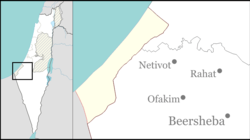Magen
מָגֵן | |
|---|---|
 | |
| Coordinates: 31°17′59″N 34°25′37″E / 31.29972°N 34.42694°E | |
| Country | Israel |
| District | Southern |
| Council | Eshkol |
| Affiliation | Kibbutz Movement |
| Founded | 16 August 1949 |
| Founded by | Romanian Jews |
| Population (2021)[1] | 537 |
| Website | www.magen.org.il |
Magen (Hebrew: מָגֵן, lit. 'Shield') is a kibbutz in southern Israel. Located in the north-western Negev desert and covering 8,500 dunams, it falls under the jurisdiction of Eshkol Regional Council. In 2021, it had a population of 537.[1]
History


During World War I, British forces established an air base here after the withdrawal of the Turks.[2] The kibbutz was established by immigrants from Romania on 16 August 1949. The site was on the remains of the Maqam (shrine) of Sheikh Nuran, either the site of the biblical town of Bethul (Joshua 19:4)[3] or the site of a fourth-century Byzantine monastery.[4] It was a battlefield during Operation Assaf in the 1948 Arab–Israeli war.
The swimming pool at the 1996 Atlanta Olympics, at which the Israeli 4×100 meters medley relay squad made the finals, was heated by solar panels manufactured by the kibbutz.[5]
During the 2023 Israel–Hamas war, Magen was one of the Israeli villages that was attacked, but its civil defense team managed to fight off the attackers.[6] Israeli forces counterattacked with tanks the following day, successfully eliminating the remaining Hamas assailants in the vicinity of the kibbutz.[7]
Archaeology
A church complex consisting of four buildings was discovered at kibbutz Magen which sheds light on features of church construction during the Byzantine period.[8][9] It was a basilica dedicated to St. Elias.[9] Mosaics, inscriptions, glass, pottery and several coins were unearthed in these excavations.[8][9]
References
- ^ a b "Regional Statistics". Israel Central Bureau of Statistics. Retrieved 22 February 2023.
- ^ John D. Grainger (2006). The Battle for Palestine, 1917. The Boydell Press. pp. 102, 154–155.
- ^ Carta's Official Guide to Israel and Complete Gazetteer to all Sites in the Holy Land. (3rd edition 1993) Jerusalem, Carta, p.307, ISBN 965-220-186-3
- ^ Alois Musil, Arabia Petraea, 3 vols. [German] (Vienna: Kaiserliche Akademie der Wissenschaften, 1908), 2:226, vol. 2, part 1.
- ^ Kibbutz Magen
- ^ "How one Kibbutz in Israel fought off Hamas: report". The Sunday Times. 15 October 2023.
- ^ Fabian, Emanuel. "Heavy gun battle, tank fire reported in Magen community near Gaza border". The Times of Israel. Retrieved 8 October 2023.
- ^ a b An Early Christian Church Complex at Magen
- ^ a b c "XXXVI. Kissufim", Volume 3 South Coast: 2161-2648, De Gruyter, p. 542, 2014-07-14, doi:10.1515/9783110337679.541, ISBN 978-3-11-033767-9, retrieved 2024-02-25
External links
- Official website (in Hebrew)


